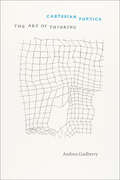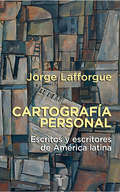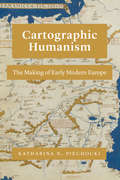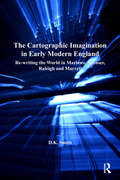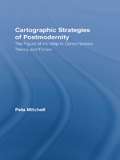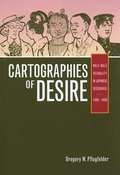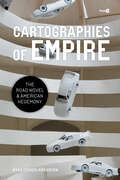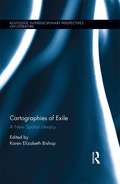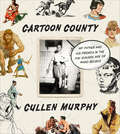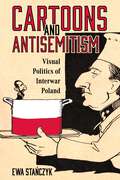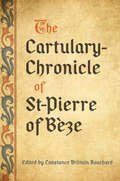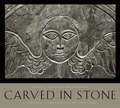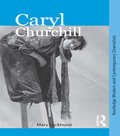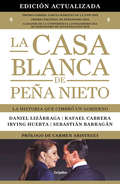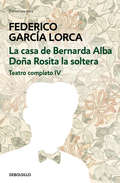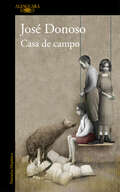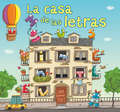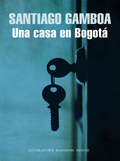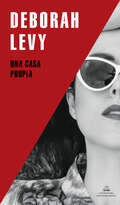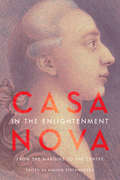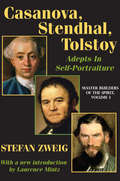- Table View
- List View
Cartesian Poetics: The Art of Thinking (Thinking Literature)
by Andrea GadberryWhat is thinking? What does it feel like? What is it good for? Andrea Gadberry looks for answers to these questions in the philosophy of René Descartes and finds them in the philosopher’s implicit poetics. Gadberry argues that Descartes’s thought was crucially enabled by poetry and shows how markers of poetic genres from love lyric and elegy to the puzzling forms of the riddle and the anagram betray an impassioned negotiation with the difficulties of thought and its limits. Where others have seen Cartesian philosophy as a triumph of reason, Gadberry reveals that the philosopher accused of having “slashed poetry’s throat” instead enlisted poetic form to contain thought’s frustrations. Gadberry’s approach to seventeenth-century writings poses questions urgent for the twenty-first. Bringing literature and philosophy into rich dialogue, Gadberry centers close reading as a method uniquely equipped to manage skepticism, tolerate critical ambivalence, and detect feeling in philosophy. Helping us read classic moments of philosophical argumentation in a new light, this elegant study also expands outward to redefine thinking in light of its poetic formations.
Carthage in Virgil’s Aeneid: Staging the Enemy Under Augustus (Cambridge Classical Studies)
by Elena GiustiFounded upon more than a century of civil bloodshed, the first imperial regime of ancient Rome, the Principate of Caesar Augustus, looked at Rome's distant and glorious past in order to justify and promote its existence under the disguise of a restoration of the old Republic. In doing so, it used and revisited the history and myth of Rome's major success against external enemies: the wars against Carthage. This book explores the ideological use of Carthage in the most authoritative of the Augustan literary texts, the Aeneid of Virgil. It analyses the ideological portrait of Carthaginians from the middle Republic and the truth-twisting involved in writing about the Punic Wars under the Principate. It also investigates the mirroring between Carthage and Rome in a poem whose primary concern was rather the traumatic memory of Civil War and the subsequent subversion of Rome's Republican institutions through the establishment of Augustus' Principate.<P><P> Provides a new literary and historicist reading of Virgil's Aeneid and its Augustan context.<P> Investigates afresh the ideology of Caesar Augustus in relation to the wider history of ideologies and autocratic regimes.<P> Engages in a range of approaches of great current interest, such as the representation of the other and the erasure of subalterns from classical texts.
Cartografía personal: Escritos y escritores de América Latina
by Jorge LafforgueCartografía personal no sólo condensa con lucidez y humor momentos sobresalientes de las letras latinoamericanas. También es una i nvitación amable a volver la mirada sobre escritos y escritores descollantes, cuyo rostro el autor se empeña en dibujar con pulso decidido y palabra sagaz. Cartografía personal no sólo condensa con lucidez y humor momentos sobresalientes de las letras latinoamericanas. También es una invitación amable a volver la mirada sobre escritos y escritores descollantes, cuyo rostro el autor se empeña en dibujar con pulso decidido y palabra sagaz. Toda cartografía que intente dibujar el mapa de la literatura latinoamericana será siempre una aproximación. Porque ese mapa es uno y es múltiple. Su trazado carece de una fórmula fija, y su continuo movimiento tampoco permite establecerlo. De ahí que esta Cartografía recurra a diversos procedimientos para acercarse a ese mapa esquivo: entrevistas a Pablo Neruda, Borges y Jorge Amado conviven con ensayos sobre el boom de los sesenta o estrategias de los escritores para salvaguardar su oficio bajo la dictadura, así como con pormenorizados estudios críticos, rescates testimoniales y apuntes imprescindibles para trazar un panorama de la producción literaria de la segunda mitad del siglo XX. La extensa trayectoria de Jorge Lafforgue como crítico, docente y periodista establece los cimientos de esta estructura heterogénea, y la argamasa que la une es su voz particular, única, fruto de una intensa experiencia con la mejor literatura.
Cartographic Humanism: The Making of Early Modern Europe
by Katharina N. PiechockiPiechocki calls for an examination of the idea of Europe as a geographical concept, tracing its development in the 15th and 16th centuries. What is “Europe,” and when did it come to be? In the Renaissance, the term “Europe” circulated widely. But as Katharina N. Piechocki argues in this compelling book, the continent itself was only in the making in the fifteenth and sixteenth centuries.Cartographic Humanism sheds new light on how humanists negotiated and defined Europe’s boundaries at a momentous shift in the continent’s formation: when a new imagining of Europe was driven by the rise of cartography. As Piechocki shows, this tool of geography, philosophy, and philology was used not only to represent but, more importantly, also to shape and promote an image of Europe quite unparalleled in previous centuries. Engaging with poets, historians, and mapmakers, Piechocki resists an easy categorization of the continent, scrutinizing Europe as an unexamined category that demands a much more careful and nuanced investigation than scholars of early modernity have hitherto undertaken. Unprecedented in its geographic scope, Cartographic Humanism is the first book to chart new itineraries across Europe as it brings France, Germany, Italy, Poland, and Portugal into a lively, interdisciplinary dialogue.
The Cartographic Imagination in Early Modern England: Re-writing the World in Marlowe, Spenser, Raleigh and Marvell
by D.K. SmithWorking from a cultural studies perspective, author D. K. Smith here examines a broad range of medieval and Renaissance maps and literary texts to explore the effects of geography on Tudor-Stuart cultural perceptions. He argues that the literary representation of cartographically-related material from the late fifteenth to the early seventeenth century demonstrates a new strain, not just of geographical understanding, but of cartographic manipulation, which he terms, "the cartographic imagination." Rather than considering the effects of maps themselves on early modern epistemologies, Smith considers the effects of the activity of mapping-the new techniques, the new expectations of accuracy and precision which developed in the sixteenth century-on the ways people thought and wrote. Looking at works by Spenser, Marlowe, Raleigh, and Marvell among other authors, he analyzes how the growing ability to represent physical space accurately brought with it not just a wealth of new maps, but a new array of rhetorical techniques, metaphors, and associations which allowed the manipulation of texts and ideas in ways never before possible.
Cartographic Strategies of Postmodernity: The Figure of the Map in Contemporary Theory and Fiction (Routledge Studies in Twentieth-Century Literature)
by Peta MitchellThe last fifty years have witnessed the growing pervasiveness of the figure of the map in critical, theoretical, and fictional discourse. References to mapping and cartography are endemic in poststructuralist theory, and, similarly, geographically and culturally diverse authors of twentieth-century fiction seem fixated upon mapping. While the map metaphor has been employed for centuries to highlight issues of textual representation and epistemology, the map metaphor itself has undergone a transformation in the postmodern era. This metamorphosis draws together poststructuralist conceptualizations of epistemology, textuality, cartography, and metaphor, and signals a shift away from modernist preoccupations with temporality and objectivity to a postmodern pragmatics of spatiality and subjectivity. Cartographic Strategies of Postmodernity charts this metamorphosis of cartographic metaphor, and argues that the ongoing reworking of the map metaphor renders it a formative and performative metaphor of postmodernity.
Cartographies Of Desire: Male-male Sexuality In Japanese Discourse, 1600-1950
by Gregory M. PflugfelderIn this sweeping study of the mapping and remapping of male-male sexuality over four centuries of Japanese history, Gregory Pflugfelder explores the languages of medicine, law, and popular culture from the seventeenth century through the American Occupation. Pflugfelder opens with fascinating speculations about how an Edo translator might grapple with a twentieth-century text on homosexuality, then turns to law, literature, newspaper articles, medical tracts, and other sources to discover Japanese attitudes toward sexuality over the centuries. During each of three major eras, he argues, one field dominated discourse on male-male sexual relations: popular culture in the Edo period (1600-1868), jurisprudence in the Meiji period (1868-1912), and medicine in the twentieth century. This multidisciplinary and theoretically engaged analysis will interest not only students and scholars of Japan but also readers of gay studies, literary studies, gender studies, and cultural studies.
Cartographies of Disappearance: Vestiges of Everyday Life in Literature (Toronto Iberic)
by Enric BouThe everyday can be defined as the routine that happens day after day and becomes our most permanent reality. It is made up of different identifiable areas of life, such as the home, the street, the subway, the park, the workplace, and local institutions. Focusing on literary texts and artistic forms, Cartographies of Disappearance addresses representations of everyday life from varying perspectives. Opening our eyes to a new understanding of our daily environment, the book presents detailed readings of texts, practices, and mythologies of everyday life within Spanish and Catalan culture. Enric Bou examines how and to what extent issues of identity, space, memory, and immigration have impacted everyday life in Spain. The book explores five major instances of representing the everyday in literature and the arts: routines and disappearances, observations of the nearby, the uses of public transportation, thanatourism, and food. Acknowledging that the everyday is a matter of study and observation, the book reveals how to look at the world from a different perspective. While the everyday is filled with the unorganized accumulation of objects and beings, Cartographies of Disappearance addresses the inclination to make sense of it all.
Cartographies of Empire: The Road Novel and American Hegemony (Post*45)
by Myka Tucker-AbramsonThe road novel is often dismissed as a mundane, nostalgic genre: Jack, Sal, and other tedious white men on the road trying to recapture an authentic youth and American past that never existed. Yet, new road novels appear every year, tackling unexpected questions and spanning new geographies, from Mexico, Brazil, Bulgaria, Palestine, Ukraine, and former-Yugoslavia. Why did the road novel emerge and why does it persist? What does it do and why has it traveled so widely? Myka Tucker-Abramson draws from an archive of more than 140 global road novels from over twenty countries, challenging dominant conceptions of the road novel as primarily concerned with American experiences and subjectivities. Grounding her analysis in materialist theories of genre, world-ecology and commodity frontier frameworks, and post-45 American literary studies, Tucker-Abramson persuasively argues that the road novel is a genre specific to, coterminous with, and revealing of US hegemony's global trajectory. Shifting our focus from Americanness to the fraught geopolitics of US Empire, from the car to the built environment through which it moves, and from passengers to those left behind, Tucker-Abramson remaps the road novel, elucidating the genre's unique ability both to reveal the violent and vertiginous processes of capitalist modernization and to obfuscate these harsh truths through seductive narratives of individual success and failure.
Cartographies of Exile: A New Spatial Literacy (Routledge Interdisciplinary Perspectives on Literature)
by Karen Elizabeth BishopThis book proposes a fundamental relationship between exile and mapping. It seeks to understand the cartographic imperative inherent in the exilic condition, the exilic impulses fundamental to mapping, and the varied forms of description proper to both. The vital intimacy of the relationship between exile and mapping compels a new spatial literacy that requires the cultivation of localized, dynamic reading practices attuned to the complexities of understanding space as text and texts as spatial artifacts. The collection asks: what kinds of maps do exiles make? How are they conceived, drawn, read? Are they private maps or can they be shaped collectively? What is their relationship to memory and history? How do maps provide for new ways of imagining the fractured experience of exile and offer up both new strategies for reading displacement and new displaced reading strategies? Where does exilic mapping fit into a history of cartography, particularly within the twentieth-century spatial turn? The original work that makes up this interdisciplinary collection presents a varied look at cartographic strategies employed in writing, art, and film from the pre-Contact Americas to the Renaissance to late postmodernism; the effects of exile, in its many manifestations, on cartographic textual systems, ways of seeing, and forms of reading; the challenges of traversing and mapping unstable landscapes and restrictive social and political networks; and the felicities and difficulties of both giving into the map and attempting to escape the map that provides for exile in the first place. Cartographies of Exile will be of interest to students and scholars working in literary and cultural studies; gender, sexuality, and race studies; anthropology; art history and architecture; film, performance, visual studies; and the fine arts.
Cartoon County: My Father and His Friends in the Golden Age of Make-Believe
by Cullen MurphyA poignant history of the cartoonists and illustrators from the Connecticut SchoolFor a period of about fifty years, right in the middle of the American Century, many of the the nation’s top comic-strip cartoonists, gag cartoonists, and magazine illustrators lived within a stone’s throw of one another in the southwestern corner of Connecticut—a bit of bohemia in the middle of those men in their gray flannel suits. Cullen Murphy’s father, John Cullen Murphy, drew the wildly popular comic strips Prince Valiant and Big Ben Bolt, and was the heart of this artistic milieu. Comic strips and gag cartoons read by hundreds of millions were created in this tight-knit group—Superman, Beetle Bailey, Snuffy Smith, Rip Kirby, Hagar the Horrible, Hi and Lois, Nancy, Sam & Silo, Amy, The Wizard of Id, The Heart of Juliet Jones, Family Circus, Joe Palooka, and The Lockhorns, among others. Cartoonists and their art were a pop-cultural force in a way that few today remember. Anarchic and deeply creative, the cartoonists were independent spirits whose artistic talents had mainly been forged during service in World War II.Illustrated with never-before-seen photographs, cartoons, and drawings, Cartoon County brings the postwar American era alive, told through the relationship of a son to his father, an extraordinarily talented and generous man who had been trained by Norman Rockwell. Cartoon County gives us a glimpse into a very special community—and of an America that used to be.
Cartoons and Antisemitism: Visual Politics of Interwar Poland
by Ewa StańczykAntisemitic caricatures had existed in Polish society since at least the mid-nineteenth century. But never had the devastating impacts of this imagery been fully realized or so blatantly apparent than on the eve of the Second World War. In Cartoons and Antisemitism: Visual Politics of Interwar Poland, scholar Ewa Stańczyk explores how illustrators conceived of Jewish people in satirical drawing and reflected on the burning political questions of the day. Incorporating hundreds of cartoons, satirical texts, and newspaper articles from the 1930s, Stańczyk investigates how a visual culture that was essentially hostile to Jews penetrated deep and wide into Polish print media. In her sensitive analysis of these sources, the first of this kind in English, the author examines how major satirical magazines intervened in the ongoing events and contributed to the racialized political climate of the time.Paying close attention to the antisemitic tropes that were both local and global, Stańczyk reflects on the role of pictorial humor in the transmission of visual antisemitism across historical and geographical borders. As she discusses the communities of artists, publishers, and political commentators who made up the visual culture of the day, Stańczyk tells a captivating story of people who served the antisemitic cause, and those who chose to oppose it.
The Cartulary-Chronicle of St-Pierre of Béze (Medieval Academy Books)
In the early twelfth century a Burgundian monk set out to tell the 500-year history of his monastery, embedded within a broader history of early medieval France. The Cartulary-Chronicle of St.-Pierre of Bèze is both a history of the monastery and a collection of its 331 charters, from its seventh-century foundation until the middle of the twelfth century. Bèze was a Benedictine house whose history included at least six incidents of sacking and destruction – and according to its twelfth-century chronicler it always recovered and emerged stronger than ever. Combining the history of Burgundy and Francia with the history of his house, John, the chronicler, created a past for Bèze as he wanted it to be remembered. Based on John’s autograph manuscript, The Cartulary-Chronicle of St.-Pierre of Bèze is published here in full for the first time. While the monks of Bèze have often been overshadowed by their more famous neighbors, the monks of Dijon, this edition recounts the history of one of the oldest houses in Burgundy and gives it its proper due.
Carved in Stone: The Artistry of Early New England Gravestones
by Thomas E. Gibson William GilsonEvocative photographs and essay illuminate early American gravestones Gravestones are colonial America's earliest sculpture and they provide a unique physical link to the European people who settled here. Carved in Stone book is an elegant collection of over eighty fine duotone photographs, each a personal meditation on an old stone carving, and on New England's past, where these stones tell stories about death at sea, epidemics such as small pox, the loss of children, and a grim view of the afterlife. The essay is a graceful narrative that explores a long personal involvement with the stones and their placement in New England landscape, and attempts to trace the curious and imperfectly documented story of carvers. Brief quotes from early New England writers accompany the images, and captions provide basic information about each stone. These meditative portraits present an intimate view of figures from New England graveyards and will be enjoyed by anyone with an interest in early Americana and fine art photography.
The Carver Chronotope: Contextualizing Raymond Carver (Studies in Major Literary Authors #Vol. 23)
by G.P. LainsburyRaymond Carver's fiction is widely known for its careful documentation of lower-middle-class North America in the 1970s and 80s. Building upon the realist understanding of Carver's work, Raymond Carver's Chronotope uses a central concept of Bakhtin's novelistics to formulate a new context for understanding the celebrated author's minimalist fiction. G. P. Lainsbury describes the critical reception of Carver's work and stakes out his own intellectual and imaginative territory by arguing that Carver's fiction can be understood as diffuse, fragmentary, and randomly ordered. Offering a fresh analysis of Carver's body of work, this book offers an extensive meditation on this major figure in postmodern U.S. fiction.
Caryl Churchill (Routledge Modern and Contemporary Dramatists)
by Mary LuckhurstOne of Europe's greatest playwrights, Caryl Churchill has been internationally celebrated for four decades. She has exploded the narrow definitions of political theatre to write consistently hard-edged and innovative work. Always unpredictable in her stage experiments, her plays have stretched the relationships between form and content, actor and spectator to their limits. This new critical introduction to Churchill examines her political agendas, her collaborations with other practitioners, and looks at specific production histories of her plays. Churchill's work continues to have profound resonances with her audiences and this book explores her preoccupation with representing such phenomena as capitalism, genocide, environmental issues, identity, psychiatry and mental illness, parenting, violence and terrorism. It includes new interviews with actors and directors of her work, and gathers together source material from her wide-ranging career.
La Casa Blanca de Peña Nieto (edición actualizada): La historia que cimbró a un gobierno
by Daniel Lizarraga Rafael Cabrera Irving Huerta Sebastián BarragánNueva edición, actualizada y con capítulos nuevos: ¿qué pasó con la Casa Blanca, símbolo de la corrupción? Premio Gabriel García Márquez de la FNPI 2015 Premio Nacional De Periodismo 2014 Ganador de la Conferencia Latinoamericana de Periodismo de Investigación 2015 En 2015, este libro dejó en evidencia a Enrique Peña Nieto, a su esposa y a su gobierno. Y hoy, esta nueva edición relata qué pasó con la Casa Blanca, con los empresarios vinculados a ella y con la persecución desatada contra los periodistas que la investigaron. Aquí está el mejor retrato de un sexenio doloroso e impune, en el que el primer círculo de poder estuvo más interesado en hacer negocios con particulares que en gobernar. #El enojo [de Enrique Peña Nieto] por ser exhibido es algo que -a diferenciade lo que él recomienda a los padres de Ayotzinapa- no ha podido superar.# Carmen Aristegui
La casa de Bernarda Alba | Doña Rosita la soltera (Teatro completo #4)
by Federico García LorcaLa casa de Bernarda Alba | Doña Rosita la soltera es el séptimo y último volumen de la Biblioteca Federico García Lorca y el cuarto de los que reúnen su «Teatro completo» . En este volumen se ofrecen al lector clásicos lorquianos como La casa de Bernarda Alba y Doña Rosita la soltera. Asimismo, se incluyen conferencias y charlas ofrecidas por el poeta en torno a sus textos, lo que permite una aproximación aún más personal a su obra. La edición y los prólogos, a cargo de Miguel García-Posada, permiten al lector acercarse a la complejidad de su obra y disfrutar, a lo largo de los siete volúmenes que componen esta Biblioteca Federico García Lorca, de uno de los autores españoles más relevantes del siglo XX. Luis Buñuel dijo...«De todos los seres vivos que he conocido, Federico era el primero. Ya se pusiera al piano para interpretar a Chopin, ya improvisarauna pantomima o una breve escena teatral, era irresistible. Era como una llama.» --------------------------------------------------------------------------BIBLIOTECA FEDERICO GARCÍA LORCA Poesía competa:1. Libro de poemas | Primeras canciones | Canciones2. Romancero gitano | Poema del cante jondo3. Poeta en Nueva York | Sonetos Teatro completo:4. La zapatera prodigiosa | Mariana Pineda5. El público | Así que pasen cinco años6. Bodas de sangre | Yerma7. La casa de Bernarda Alba | Doña Rosita la soltera--------------------------------------------------------------------------
Casa de campo
by José DonosoLa gran metáfora histórica de Donoso; la representación en clave del Chile de los años 70 y del golpe militar. Casa de campo es una brillante alegoría del poder y la rebelión. La mansión señorial donde los Ventura, sus cónyuges y sus treinta y cinco hijos pasan el verano, lejos de la civilización, se alza como un espejismo en medio de la llanura. Por sus salones, pasillos, escalinatas y torreones deambulan los niños, poblando la casa con intrigas, transgresiones y juegos que cuestionan una perversión mayor: el orden impuesto por sus aristocráticos padres. Los Ventura organizan un fastuoso día de campo para los mayores, y encierran a sus hijos en la enorme mansión, cercada por una reja de lanzas... ¿Qué hay más allá? La llanura ilimitada, los antropófagos, la naturaleza y sus fuerzas nodomadas. Pero también en los niños anida la subversión. Y están solos.
La casa de las letras
by Ana Punset Lucía SerranoUn divertido y original álbum ilustrado con cuentos protagonizados por las letras del abecedario. ¡Descubre las aventuras de estos vecinos tan especiales! La casa de las letraste abre hoy sus puertas.Ven a conocerlas y verásque todas tienen su personalidad.Con tus amigas las letras,no te aburrirás jamás. En la casa de las letras vive el abecedario completo. Descubre las aventuras más divertidas de cada una de las letras. La P de parlanchina, la M de motorista..., consonantes y vocales, todas viven aquí, en el edificio más loco y divertido de toda la ciudad. ¡La manera más divertida de aprender las letras! * Y si quieres aprender los números, descubre el álbum de cuentos La casa de los números.
Una casa en Bogotá
by Santiago GamboaGracias al Premio Internacional Rubén BonifazNuño, en la categoría de ensayo, el filólogo nar radorde estas pág inas puede comprar su casa. Después detoda una vida de desearla, de obser varla, de acercar sea sus paredes de piedra y ladrillo rojo para descifrar elenigma de su atracción, logra por fin saberla suya, yen el momento en el que franquea el umbral comosu dueño, reconoce en ella su destino, su lugar en elmundo, el espacio a la medida de sus gustos y de suconcepción de la vida.La instalación en esta vieja casona bogotana es unproceso paciente y, más que físico, reflexivo y memorístico.Pues cada r incón, la madera de los pisos, losbaños, el comedor, la vajilla, la biblioteca, las habitaciones,la mansarda, incluso el bar rio entrevisto por lasventanas, dan pie a un viaje fascinante por la vida delprotagonista. Conocemos de su existencia itineranteen compañía de su tía, sus preocupaciones intelectuales,su amor por los libros y la lengua, sus ricas experiencias sexuales, su descubrimiento del lado oscurode las ciudades, así como las estelas de una remotatragedia que lo persigue desde la niñez.
Una casa propia
by Deborah LevyEl cierre de la Autobiografía en construcción de una Deborah Levy que logra su habitación propia. Deborah Levy imagina una casa en una latitud cálida, cerca de un lago o de un mar. Allí hay una chimenea y un mayordomo que atiende sus deseos, hasta el de discutir. Pero Levy en realidad está en Londres, no tiene dinero para construir el hogar que imagina, su apartamento es minúsculo y lo más parecido a un jardín en su casa es un banano al que entrega los cuidados que sus hijas ya no necesitan. La menor ha abandonado el nido, y Levy, a sus cincuenta y nueve años, está lista para afrontar una nueva etapa en su vida. Así, nos lleva desde Nueva York a Bombay, pasando por París y Berlín, mientras teje una estimulante y audaz reflexión sobre el significado del hogar y de los espectros que lo acechan. Entretejiendo el pasado y el presente, lo personal y lo político, y convocando a Marguerite Duras, Elena Ferrante, Georgia O’Keeffe o Céline Schiamma, la autora indaga en el significado de la feminidad y de la propiedad. A través de sus recuerdos hace inventario de sus posesiones reales e imaginarias y cuestiona nuestra forma de entender el valor de la vida intelectual y cotidiana de la mujer. Después de Cosas que no quiero saber y El coste de vivir, esta obra es la culminación de una autobiografía escrita en el fragor de una vida que no está solamente protagonizada por Levy, sino por todas las mujeres que la sostienen con una red invisible. Reseñas: «La voz imprevisible, tierna, incisiva, entristecida y entusiasta de la Levy biógrafa ofrece un festín literario.»Gonzalo Torné, El Cultural «Por supuesto, Levy es feminista, su autobiografía desvela no solo una postura como mujer, también esa visión impregna otros temas como la migración, el imperialismo, el racismo o el amor. Estos textos según Levy tenían que narrar dos aspectos que nunca coexisten: el poder de los hombres y la vulnerabilidad que se permite la mujer al escribir.» Ariana Basciani, The Objective Sobre Cosas que no quiero saber: «Una narración vivaz y brillante sobre cómo los detalles más inocentes de la vida personal de una escritora pueden alcanzar el poder en la ficción.»The New York Times Book Review «Un relato vívido y sorprendente de la vida de la escritora, que feminiza y personaliza las contundentes a afirmaciones de Orwell.»The Spectator Sobre El coste de vivir: «Derrocha en el segundo tomo de su autobiografía tanto hallazgos expresivos como verdades acendradas [...] en un tapiz algo descosido que sin embargo se lee con delectación y donde rubrica sobre todo el regreso a los planteamientos de Simone de Beauvoir en El segundo sexo; esto es, vuelve a admitir la dificultad desquiciante de conjugar pareja, maternidad e independencia intelectual.»El Periódico «El coste de vivir es el precio que debe pagar una mujer para desmontar un hogar en el que ya no se siente como en casa. Para Levy, este acto radical da inicio a la búsqueda de una nueva vida que resulta inseparable de la búsqueda de una nueva narrativa.»The Times
Casablanca (SparkNotes Film Guide)
by SparkNotesCasablanca (SparkNotes Film Guide) Making the reading experience fun! SparkNotes Film Guides are one-stop guides to great works of film–masterpieces that are the foundations of filmmaking and film studies. Inside each guide you&’ll find thorough, insightful overviews of films from a variety of genres, styles, and time periods. Each film guide contains:Information about the director and the context in which the film was made Thoughtful analysis of major characters Details about themes, motifs, and symbols Explanations of the most important lines of dialogue In-depth discussions about what makes a film so remarkable SparkNotes Film Guides are an invaluable resource for students or anyone who wants to gain a deeper understanding of the great films they know and love.
Casanova in the Enlightenment: From the Margins to the Centre (UCLA Clark Memorial Library Series)
Illuminating the legend that Giacomo Casanova singlehandedly created in his famous – and at times infamous – autobiography, The History of My Life, this book provides a timely reassessment of Casanova’s role and importance as an author of the European Enlightenment. From the margins of libertine authorship where he has been traditionally relegated, the various essays in this collection reposition Casanova at the heart of Enlightenment debates on medicine, sociability, gender, and writing. Based on new scholarship, this reappraisal of a key Enlightenment figure explores the period’s fascination with ethnography, its scientific societies, and its understanding of gender, medicine, and women. Casanova is here finally granted his rightful place in cultural and literary history, a place which explains his enduring yet controversial reputation as a figure of seduction and adventure.
Casanova, Stendhal, Tolstoy: Volume 3, Master Builders of the Spirit
by Jay KatzCasanova, Stendhal, Tolstoy: Adepts in Self-Portraiture, the final volume of Stefan Zweig's masterful Master Builders of the Spirit trilogy, discloses the smaller version of a writer's own ego. Unconscious though it is, no reality is as important to the writer as the reality of their own life. Giacomo Casanova, Stendhal (Marie-Henri Beyle), and Leo Tolstoy have different approaches to self-portraiture, but Zweig shows that together they symbolize three levels which represent successively ascending gradations of the same creative function.Casanova is depicted as having a primitive gradation; he simply records deeds and happenings, without any attempt to appraise them or to study the deeper working of the self. Stendhal's self-portraiture is depicted as psychological; he observes himself and investigates his own feelings. Tolstoy has the highest level; he describes his own life, records what led him to his own actions, and focuses on self-reflection in a completely unexaggerated manner.At first glance it might seem as if self-portraiture is an artist's easiest task. With no further trouble than a probing of memory and a description of the facts of life, "the truth" is revealed. The history of literature shows that ordinary autobiographers are no more than commonplace witnesses testifying to facts that chance has brought to their knowledge. A practiced artist is needed to discern the innermost happenings of the soul; few who have attempted autobiography have been successful in this difficult task. The present volume expounds the characteristics of these subjectively minded artists, and of autobiography as their typical method of personal expression.
